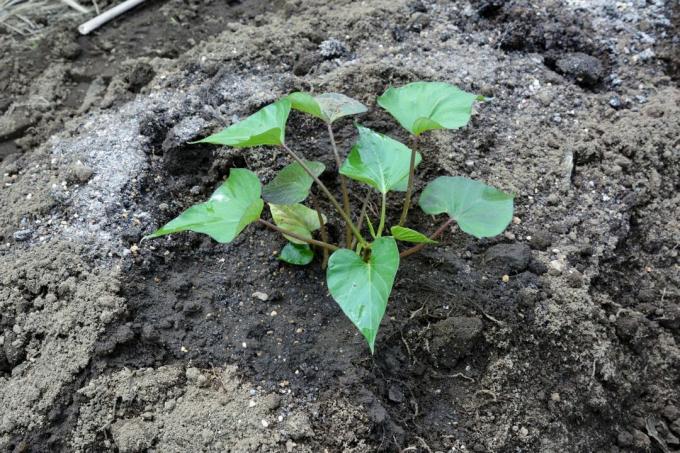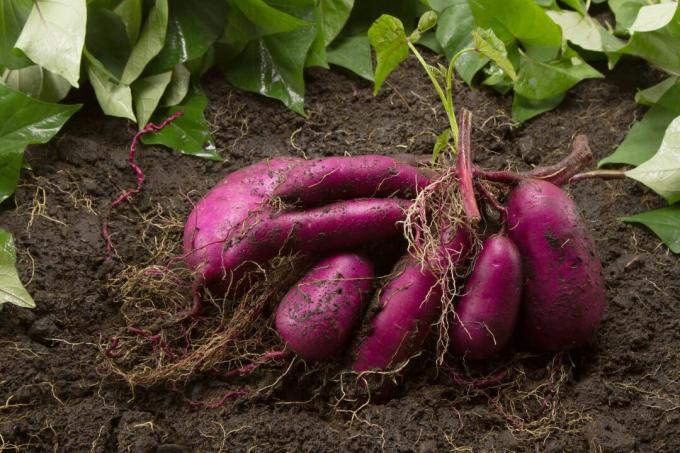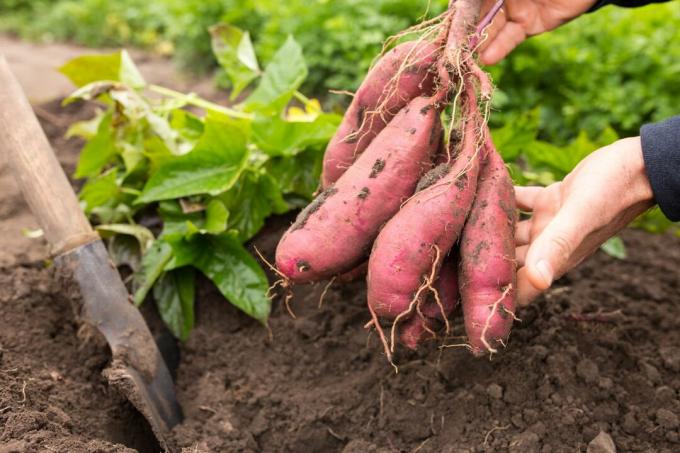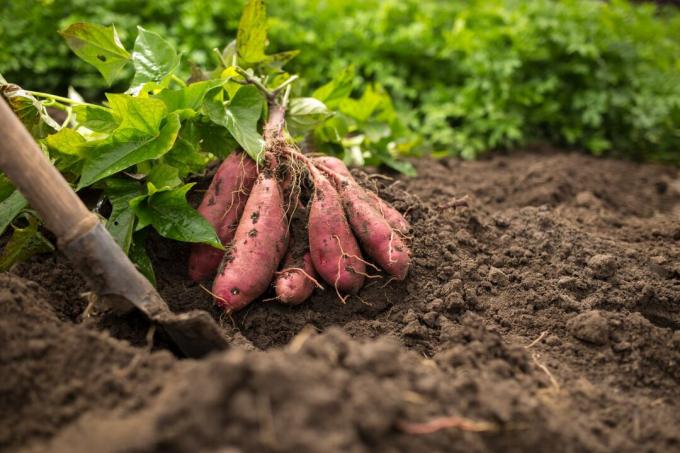Growing sweet potatoes in the garden: We present suitable varieties of young plants and give tips on planting, care and fertilization, right up to harvest.
Already in the 16th Century has the sweet potato (Ipomea batata) conquered the European market before the well-known potato. However, the sweet potato remained an exotic vegetable and the potato became an export hit at the time. Within a very short time, the "normal" potato quickly became the most important source of food in many parts of Europe. The cultivation of sweet potatoes was not pursued any further. But there is actually no logical reason for this. The sweet potato comes from the tropical and subtropical areas of South America, but with the right cultivation tricks and adapted varieties, a high harvest yield is also possible with us. The sweet potato has been the trend for a relatively short time, and this has not only arrived in the kitchen, but also in cultivation. A few years ago, field trials were carried out by the Weihenstephan-Triesdorf University of Applied Sciences. The results show that sweet potatoes can also thrive in our climates. So that you too can harvest your own sweet potatoes in the next gardening season, we have created the ultimate sweet potato growing guide for you.
contents
- This is how sweet potatoes can be propagated
-
All propagation methods at a glance
- Sweet potato cuttings
- Sweet potato tubers
- Overview of sweet potato varieties
-
Correct location for the sweet potato
- Grow sweet potatoes in the bed
- Pot culture of sweet potatoes
-
Caring for sweet potatoes
- Pour sweet potato properly
- Fertilize sweet potatoes properly
- Pests on the sweet potato
- Harvest, storage and “curing” of the sweet potato
This is how sweet potatoes can be propagated
The most important basis for the successful cultivation of sweet potatoes is the right plant material. The sweet potato is usually propagated via the tuber or cuttings. Seeds are only used very rarely, as many sweet potato varieties can usually no longer produce seeds. So, in theory, you could just buy a sweet potato from the supermarket and stick it in the ground. In warm temperatures it will then push roots and shoots after a while. There is only one problem: The variety of supermarket sweet potatoes is usually not known and it is possible that the sweet potato purchased may not be optimally adapted to our climate. To avoid disappointment during the growing season, we therefore advise you to take rooted cuttings from specialist retailers. The varieties and their properties are known there.

When you have decided on a suitable variety, you should order the cuttings as soon as possible. For a good harvest in autumn it is important that the plants are a bit bigger when they are planted in the bed. For the time on the windowsill, you should treat the young plants to a pot that is half a liter in size. You will learn why this is important later. In addition, the young plants need a lot of warmth and every ray of sunshine that spring offers. A south-facing window sill is therefore best. Avoid temperatures below 10 ° C and cool drafts by ventilating. Because even at single-digit temperatures, the sweet potato can be damaged. At temperatures around 25 ° C, however, the potato feels really good. In addition, water the plants regularly so that the substrate always remains moist (not wet!). Fertilization is not necessary if pre-fertilized soil was used for repotting. The plants now remain on the windowsill until the night temperatures no longer fall below 10 ° C. Young sweet potato plants are relatively expensive. For this reason, you should continue to propagate the purchased cuttings yourself. This is the only way to create a bed of sweet potatoes cheaply.
All propagation methods at a glance
Sweet potato cuttings
A quick and easy way to get lots of small sweet potatoes is by cuttings. The prerequisite for this is an existing plant with a few longer shoots. Cut off 10 cm long shoots from the plant. The shoots are then placed in a pot or seed tray with potting soil. Sometimes it is necessary to remove one or two of the lower leaves, otherwise the cuttings cannot be inserted deep enough into the soil. To ensure that the sensitive cuttings do not dry out until they are rooted, a high level of humidity must be ensured. You can achieve high humidity with a mini greenhouse for the windowsill, which can be had for a few euros. Now all you have to do is ensure temperatures around 25 ° C. 20 ° C is enough, but at higher temperatures the shoots root much faster. Under optimal conditions, the shoots sometimes take root after 1 to 2 weeks. The beginning of shoot growth is a sure sign of successful rooting. Now the young plants should be hardened slowly: They should be ventilated more from day to day, until the fresh sweet potatoes can do without the plastic cover entirely.
Sweet potato tubers
Of course, like the normal potato, the sweet potato can also be propagated via the tuber. So that several plants emerge from one tuber, it can be cut into several parts. Four to 5 pieces of tubers should be obtained from a sweet potato in this way. The divided tuber should not be planted directly. Allow 2 to 3 days for the interfaces to dry out. This will reduce the risk of rot. After the waiting period, the pieces of tubers can be placed in potting soil or lightly buried. It is often asked whether the tuber should be buried completely and how the sweet potato should be planted. Our answer: It doesn't matter! The new instincts find their way; Much more important is a high temperature and the correct humidity of the earth. At 20 to 25 ° C and moist soil, the first shoots should be visible after a few weeks.
Overview of sweet potato varieties
The indigenous peoples of South America already fed on the sweet potato 5,000 years ago. Through domestication, the indigenous people have contributed to today's variety of varieties. The sweet potato is now grown in almost all warm regions in the world. With around 7,000 varieties, the sweet potato offers a huge selection of different plants. Most often, the varieties differ in terms of the tuber. There are tubers with red, yellow or white skin and the color of the meat ranges from orange to white to purple. The leaves don't always have to be green either. Special cultivars are particularly suitable as an ornamental plant, as the leaves are noticeably colored. Of course, other properties also play a role. The cultivation time is particularly important for use in the home garden. Because we should only cultivate varieties with a short cultivation period. At the moment the selection of varieties in Germany is unfortunately still limited. However, this situation is likely to change quickly, as interest in sweet potatoes is growing and growing. At this point we would like to introduce you to four varieties of which young plants can also be bought. In addition, the varieties were tested by the Weihenstephan University and can all be successfully grown in Germany.

- Beauregard: Variety with a short cultivation period (90-95 days). The tuber has a red skin, the flesh is orange. In the field trial, this variety developed the largest tubers and produced a yield of 3.5 kg per m². Orange pulp varieties are high in beta-carotene.
- Bonita: This variety also delivers a reliable yield, but the tubers are slightly smaller. The skin is pink in color and the flesh is white-yellow. In the kitchen, Bonita should be a real all-rounder.
- Evangelina: The Evangelina variety is said to taste particularly fine. Maybe this is due to the relatively high sugar content. It is also suitable as an ornamental plant due to the wine-red shoot tips. The tuber color is red-purple and the flesh is orange. Cultivation time: 100 - 110 days.
- Murasaki: The Japanese breed with white meat and a pink shell is a real eye-catcher. With a sweet, nutty taste, the variety is said to be particularly suitable for chips. The culture takes a relatively long time of 120 - 130 days. The yield is not high, but the unusual tuber color makes up for it.
Unfortunately, these types of sweet potatoes are not yet available in Germany:
- Oklamex Red: The tubers have a dark red skin and a salmon-colored flesh. The sugar content is said to be particularly high in this variety.
- Sumor: The vitamin C content of this variety is said to be very high. But the variety also has a lot to offer in terms of color, because the meat has a very nice white to yellow color
- Black Hearth: The Black Hearth variety is more of an ornamental plant. The leaves have an intense purple color and should not be missing in any flower box. In well-stocked nurseries you can often find sweet potatoes with special leaf colors.

Correct location for the sweet potato
Grow sweet potatoes in the bed
The young plants should be planted outdoors after the ice saints at the earliest. However, if the nighttime temperatures are in the single digits, you should rather wait. A cold shock can cause the sweet potatoes to stagnate over a long period of time. A cold frame fleece is recommended for impatient gardeners. This protects the sensitive plants from the wind and the temperatures under the fleece are always a few degrees warmer than outdoors. In addition, the fleece initially offers protection from the sun. Because even the light-hungry sweet potato has to get used to direct sunlight first. In addition to the planting date, the location itself is of course decisive for a lush harvest:
- A full sun is preferred; Partial shade is possible but not optimal
- Light, sandy soil for good tuber formation and against waterlogging
- Cultivation also possible in the greenhouse
When the days are warm enough, the young plants can move into their new home in the bed. To do this, carefully remove the root ball from the pot. Now the root ball must be carefully loosened. This work step is important so that there are no unsightly tubers and adhesions later. In addition, for optimal growth, the plants should not simply be planted in the flat vegetable patch. When growing sweet potatoes, the dam method has proven to be particularly promising. With this technique, the sweet potato can also be grown successfully in heavy soils. For the cultivation technique, 60 cm wide and 20 cm high earth embankments are created in the bed, which are at least one meter apart. The young plants are then planted on the dams at a distance of at least 30 cm. Growing on top of a dam has two major advantages. First of all, the soil in the dam can warm up faster and this gives the sweet potato a growth advantage. In addition, excess water flows away faster and the risk of waterlogging is reduced.

At first the sweet potatoes grow very slowly and the bed offers a lot of bare earth, which should actually be avoided. That is why the sweet potato is perfect for mixed cultivation. Plants can be grown between the dams that only need a short period of time to be harvested. So you can sow lettuce, radishes or spinach there. With the mixed culture method, you prevent soil erosion and use the space in your garden much more efficiently. Now the foundation stone has been laid for high yields in autumn. In addition to fertilization, the location and propagation are decisive for successful sweet potato cultivation.
Pot culture of sweet potatoes
Sweet potatoes can of course also be grown in a tub. It is important that the bucket holds at least 20 liters of soil (for a young plant). The bucket can be set up wherever it is sunny. Black plastic buckets are best, because they convert the sun's rays into heat, making the sweet potatoes particularly cozy. A house wall made of stone can release the heat stored during the day over the night and thus also ensure higher temperatures. As with bed cultivation, a loose and permeable substrate should be used. If you have pre-fertilized well, you do not need to add any additional nutrients to begin with.
Caring for sweet potatoes
The sweet potato does not need any special care. If the bed is properly prepared and a good location has been chosen, the plant will grow by itself. Only at the beginning, when the sweet potato has not yet covered the whole bed with its creeping shoots, weeds need to be removed every now and then. Later in the season, however, weeds can usually no longer prevail against the leaf masses of the sweet potato.

Pour sweet potato properly
If the plants are still small and have few leaves, there is usually hardly any need to water. Nevertheless, you should keep in mind that the earth dams dry out faster than a normal bed. For this reason, water must always be poured when the top layer of soil has dried. When the sweet potatoes have formed a sea of leaves in summer, the water consumption also increases. In the absence of precipitation and high temperatures, watering must sometimes be carried out daily. The sweet potato can withstand short periods of drought without any problems, but later tuber formation can be negatively affected by an uneven water supply.
When growing in pots, special attention must be paid to the water supply. When the sweet potatoes are bigger, daily checking of the soil is important. That means more watering work than with the bed culture. The rule here is: the smaller the pot, the more often it has to be watered. That is why irrigation water can remain in the saucer on really hot summer days. You should only remove excess water from the coaster in the evening. Then slowly reduce the watering in autumn. The growing tubers should then not be as damp as in summer, since the root tubers of the sweet potato are relatively prone to rot.
Fertilize sweet potatoes properly
If you prepare the bed correctly at the start of the season, no additional fertilization is necessary.
- 3 liters of ripe compost and 100 g horn meal per m2 work into the earth
- if a mixed culture is created, the consumption of nutrients increases and more fertilization is required
- Alternatively, mainly organic bio-fertilizers like ours can also be used Plantura organic tomato fertilizer to be used
When growing in a tub, a single fertilization is definitely not enough. Here we recommend a light weekly fertilization with a high-quality liquid fertilizer such as our Plantura Organic tomato & vegetable fertilizer. Start administering the liquid fertilizer when the sweet potato begins to grow heavily on leaves.
Pests on the sweet potato
Here, too, we have good news: the sweet potato doesn't seem to be particularly popular with native insect pests. In the large-scale field test carried out by the Weihenstephan-Triesdorf University of Applied Sciences, no damage was observed either. However, it is reported by some gardeners that mice peck at the ripe tubers every now and then. The only thing that helps here is harvesting in good time. It is to be hoped that over time no new pests will be introduced that target the sweet potato.
Harvest, storage and “curing” of the sweet potato
Only in September does the sweet potato even begin to form nodules. Before that, all the energy is put into the formation of the leaves. The perfect harvest date is when the leaves turn yellow (October). At this time, the highest content of carbohydrates is in the tubers. However, depending on the variety or the weather, the tubers may have to be harvested earlier. Because the tubers cannot tolerate frost and must therefore be taken out of the bed before the first frost. Even if the weather throws a spanner in the works, the tubers will be tasty even with a slightly earlier harvest.

When it comes to the upcoming harvest, you need a bit of tact. The tubers only have a very thin bark, if this is damaged, the storage time is shortened and rot can occur. Most of the time you don't have to dig deep when harvesting, because the sweet potatoes are more in the upper layer of the soil. The dug out tubers should be washed thoroughly for storage and afterwards, it is best to let the sweet potatoes dry in the sun. In principle, the sweet potatoes can be consumed directly, but the batata initially have a high starch content and less sugar. The sweet potato produces less sugar and more starch, especially in the light conditions that prevail here. In other words: The sweet potatoes harvested directly here are less sweet than those from the supermarket. With a treatment, known as curing, the sugar content can be increased and the shelf life is also extended.
The curing:
- Usually carried out in special climatic chambers (4 - 10 days at 30 ° C and 80 - 95% humidity).
- The warm and humid climate closes small wounds in the peel and starch turns into sugar.
- At home, curing can be mimicked by wrapping the sweet potatoes in black foil.
- The foil pack is placed in the sun for 5 days during the day and in the warmest room at night.
Normally, sweet potatoes can be kept for 3 to 4 weeks after harvesting at 12 to 16 ° C. Temperatures below 10 degrees can cause cold damage and temperatures above 16 ° C shorten the shelf life. With the mimicked curing, the shelf life can be extended by a few weeks. Thanks to professional curing, even many months. The shelf life is also increased if there is high humidity in the storage room. In any case, only healthy tubers should be stored. For tubers with major injuries, the risk of rot spreading is too great.

In case you plan on the Potato growing in the pot We have provided additional helpful tips for you here.

